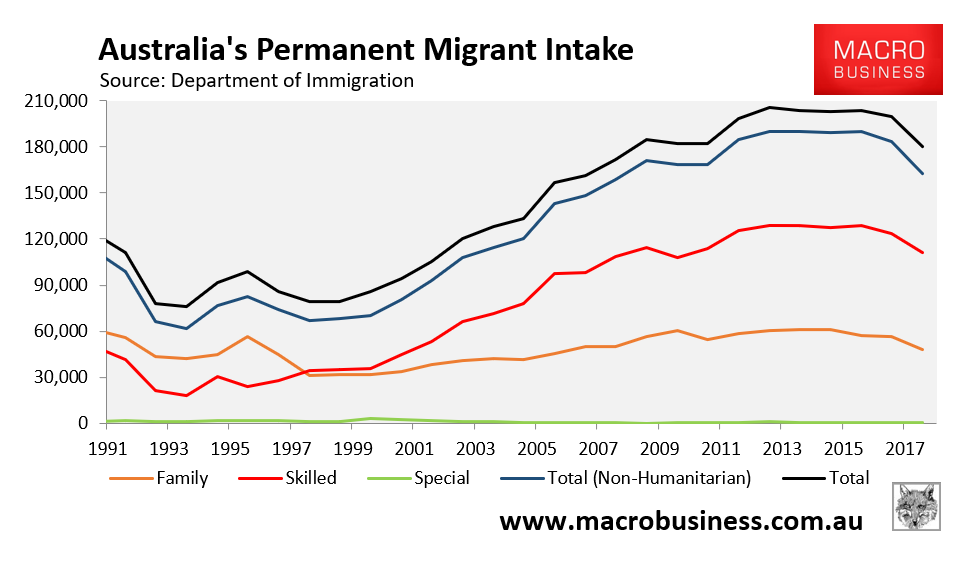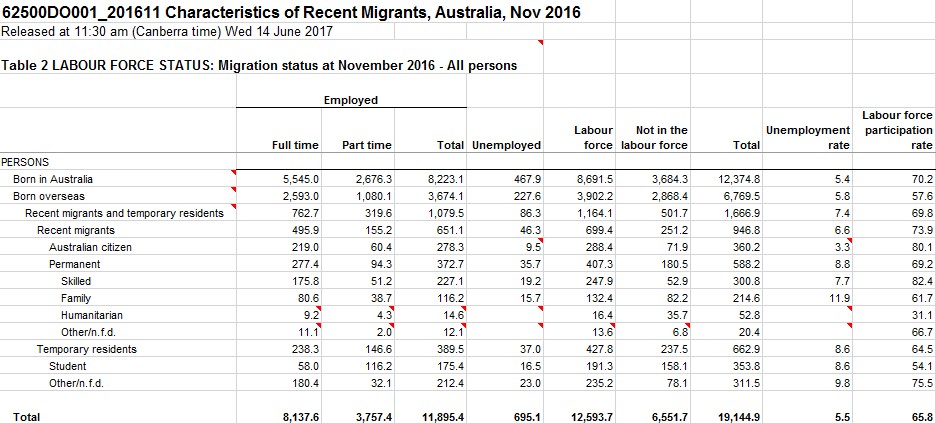It didn’t take long for Professor Peter McDonald’s immigration propaganda to infect the mainstream media, with Fairfax’s David Crowe publishing his ‘research’ as if it was fact. From The SMH:
A severe cut to migration would deprive the country of up to 6.8 million workers by 2050 while scaling back economic growth, highlighting the danger of a steep decline in the intake.
Australia’s economic output would be 12 per cent higher in 2053 in per capita terms with an annual intake of 180,000 migrants compared to a halt to the program…
The findings are a reminder of the value of the migration program…
His latest conclusions confirm that annual net overseas migration of about 200,000 a year would help address the ageing of the population, and lead to about 20.5 per cent of Australians being over the age of 65 by 2051.
The percentage of the population over 65 would rise from 15 per cent today to almost 27 per cent in 2051 if the door was closed on migrants, putting a greater burden on the rest of society to fund pensions and services for those who have retired…
While businessman Dick Smith has called for an intake of 70,000 a year, Professor McDonald said this would not be enough to cover the humanitarian and family intake… “Skilled migration would have to be negative”.
I already comprehensively destroyed Peter McDonald’s flimsy analysis on Friday, so I won’t bother to repeat my critique here. All I will say is that Peter McDonald also co-authored a parliamentary research paper in 1999 which concluded that it is “demographic nonsense to believe that immigration can help to keep our population young”, claimed that “levels of annual net migration above 80 000 become increasingly ineffective and inefficient in the retardation of ageing”, while also recommending “a population of 24-25 million within 50 years”.
The Productivity Commission, through various reports, has also comprehensively debunked Peter McDonald’s claimed ageing benefits from immigration.
Peter McDonald also claims that Australia cannot reduce immigration numbers because future generations will have to pay. Yet, Blind Freddy can see that our current generation cannot afford to pay for the infrastructure required to support the current immigration numbers, hence the worsening congestion and crush-loading across our cities.
Peter McDonald’s final claim that cutting Australia’s immigration intake would be difficult is also misleading:

The “family” migrant stream (currently 47,000) could easily be sliced by several thousand by merely following through with the Productivity Commission’s (PC) recommendations and tightening parental visas. These migrants add pressure to an already strained system and do not work, pay taxes, or contribute in any meaningful way to the economy. According to the PC:
The contributory visa charge of just under $50 000 meets only a fraction of the fiscal costs for the annual intake of roughly 7200 contributory parents. And an additional 1500 parents make a minimal contribution. Overall, the cumulated lifetime fiscal costs (in net present value terms) of a parent visa holder in 2015-16 is estimated to be between $335 000 and $410 000 per adult, which ultimately must be met by the Australian community. On this basis, the net liability to the Australian community of providing assistance to these 8700 parents over their lifetime ranges between $2.6 and $3.2 billion in present value terms. Given that there is a new inflow each year, the accumulated taxpayer liabilities become very large over time. This is a high cost for a relatively small group.
Ultimately, every dollar spent on one social program must require either additional taxes or forgone government expenditure in other areas. It seems unlikely that parent visas meet the usual standards of proven need, in contrast to areas such as mental health, homelessness or, in the context of immigration, the support of immigrants through the humanitarian stream, and foreign aid.
Given the balance of the costs and benefits, the case for retaining parent visas in their current form is weak.
Nobody should migrate to Australia with the expectation that they can bring their elderly parents along for the ride at taxpayers’ expense.
This brings me to Australia’s so-called “skilled” migrant intake. At the turn-of-the-century, the skilled intake was 35,000. Today it is 111,000 following the Coalition’s latest cuts.
We already know that the common claim by the business lobby that Australia is suffering from “skills shortages” is utterly false. We also know that Australia’s skilled migrant program has been widely rorted, attracting migrants to areas already heavily oversupplied with workers (e.g. accounting, engineering and IT), with most of these migrants employed at levels well below their claimed skills set, and ‘skilled’ migrants generally having significantly higher unemployment and underemployment than the Australian born population:
The heavy weighting towards ‘skilled’ migrants also means that Australia’s immigration system is built around robbing developing nations of their skilled human resources, thus stifling their economic development.
Therefore, the ‘skilled’ program should be phased back to 35,000 over, say, three years and be reserved only for truly world-class leaders in their field that Australia cannot foster internally. Moreover, these highly skilled migrants should have an income pay floor set at the 80th to 90th percentile of earnings.
No longer should employers simply be able to ‘grab a migrant’ to fill ordinary positions in the labour market cheaply. Instead, they would have to lift wages to attract workers (thus countering anaemic wages growth), as well as commit to training local workers.
Let’s also not forget that many migrants come to Australia on temporary visas with the hope of transitioning to a ‘skilled’ permanent visa.
Therefore, if Australia was to remove the carrot of permanent residency by slashing the ‘skilled’ intake, it would also reduce the flow of temporary migrants, since the two areas are intrinsically linked.
The flow of temporary migrants would also be stemmed by raising the appallingly low pay floor on ‘skilled’ temporary workers from $53,900 (non-indexed) to, say, the full-time average salary of $84,682 (which includes unskilled workers).
By maintaining such a low pay floor for temporary ‘skilled’ foreign workers, the government has ensured the system has been overused and abused by employers, thereby undermining the pay and working conditions of local workers. This needs to stop.
Finally, Australia’s “humanitarian” migrant intake is already fairly low and has not budged much since the turn-of-the-century (see above chart). It should remain at the current level.
In summary, by merely cutting parental visas by at least 5,000, and culling the skilled migrant intake by 76,000, Australia could easily reduce the permanent migrant intake back to around 100,000, which includes maintaining a generous humanitarian intake and the same ‘skilled’ intake that existed at the turn-of-the-century. If we want to go even further, we could tighten the rorted spousal visas.
In any event, Australians should be given a say about Australia’s future population size via a plebiscite at the upcoming federal election, the answers of which would then be used to formulate Australia’s immigration intake to meet the said target.


